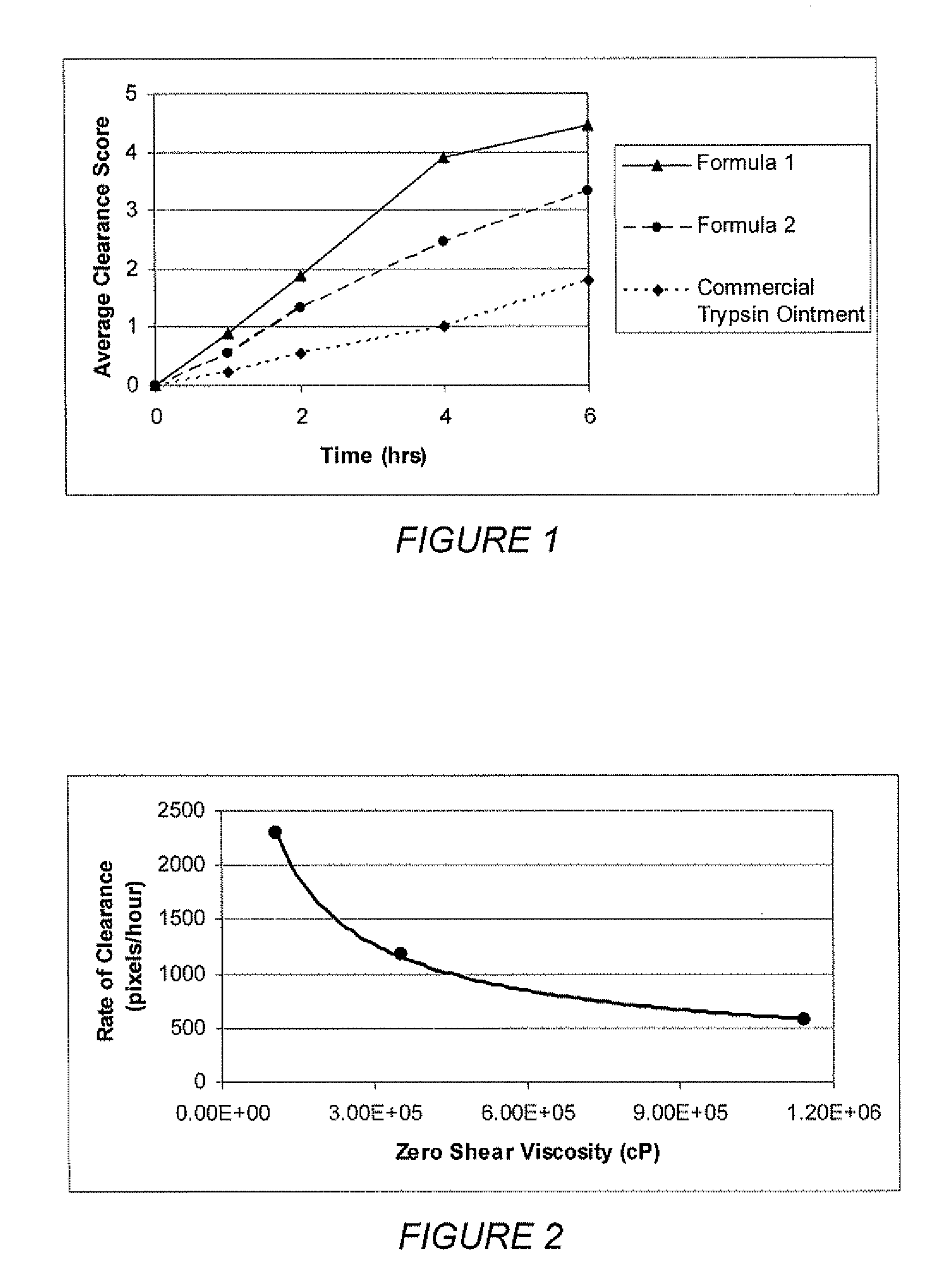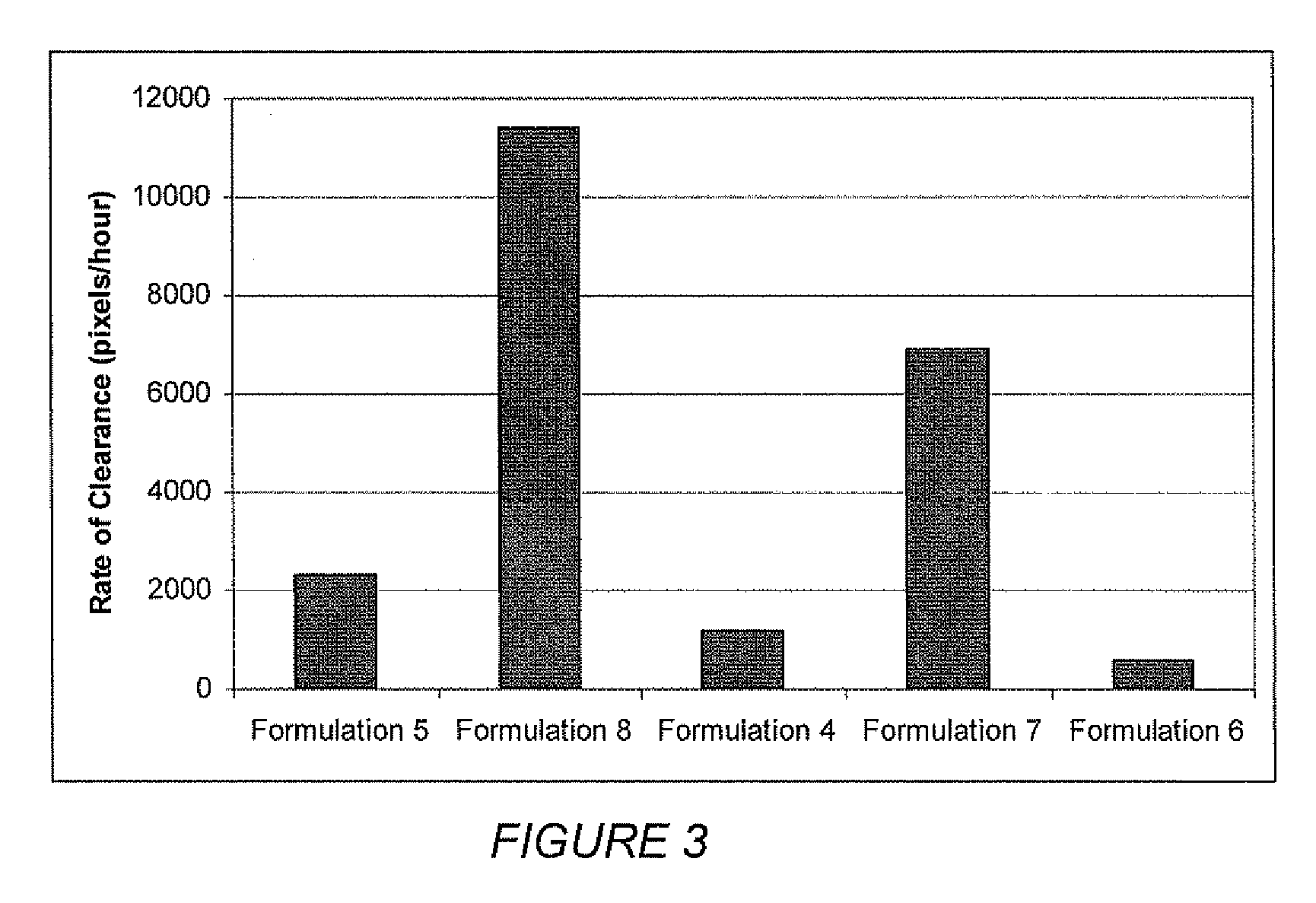Compositions for Topical Enzymatic Debridement
a technology of enzymatic debridement and composition, which is applied in the direction of drug compositions, aerosol delivery, peptide/protein ingredients, etc., can solve the problems of affecting the efficiency of the formulation, and achieve the effect of facilitating the release of actives, facilitating spraying and stabilizing, and promoting efficient dispersion of various ingredients
- Summary
- Abstract
- Description
- Claims
- Application Information
AI Technical Summary
Benefits of technology
Problems solved by technology
Method used
Image
Examples
example 2
Trypsin Formulations also Containing Colloidal Silica
[0086] To make the formulations, castor oil, safflower oil, balsam peru oil and polyoxy 10 oleyl ether are combined and stirred under low shear conditions until a uniform solution is obtained. Trypsin is then dispersed uniformly into the solution by low shear mixing. The colloidal silica is then dispersed into the suspension by low shear mixing to form a uniform suspension. The slurry is then subjected to brief high shear mixing to fully disperse the trypsin and colloidal silica allowing the suspension viscosity to fully develop. The finished formulation is packaged in standard pump dispensing packaging. This procedure was used to prepare the formulations given in table 2 below.
TABLE 2FormulationFormu-Formu-Formu-Formu-Formu-lationlationlationlationlation45678IngredientWeight %Weight %Weight %Weight %Weight %Castor Oil78.878.878.878.878.8Colloidal2.51.753.52.52.0SilicaBalsam of8.78.78.78.78.7Peru OilPolyoxy 1022222.0Oleyl Ether...
example 3
[0087] To make a Formulation concentrate, castor oil (738 gm) is placed in a stirred container. In separate containers, balsam oil (93 grams) and Oleth-10 surfactant (68 gm) are heated to 50° C., and the heated ingredients are added to the castor oil. The mixture is stirred to blend it. A portion of the mixture (about 100 gm) is taken and 1 gm of trypsin is added to it. The trypsin / oil mixture is processed in a colloid mill for at least 5 passes. Meanwhile, 50 g of polyoxyl 60 hydrogenated castor oil, m.p. ca. 40° C., is melted and added with stirring to the castor oil mixture. After the mixture returns to room temperature, the trypsin / castor oil dispersion is added with stirring. The finished Formulation concentrate is charged to aluminum spray cans (90 g), and then 28 g per can of HFC 134a is added under pressure. A satisfactory spray is obtained, resulting in a thick, viscous coating that becomes waxy as the propellant evaporates.
example 4
Aerosol Trypsin Formulation 10 Containing Colloidal Silica
[0088] To make a Formulation concentrate, castor oil (788 gm) is placed in a stirred container. Balsam oil (87 grams), Oleth-10 surfactant (20 gm) and Safflower Oil (87.38 gm) are added to the castor oil. The mixture is stirred to blend it. A portion of the mixture (about 100 gm) is taken and 0.12 gm of trypsin is added to it. The trypsin / oil mixture is processed in a colloid mill for at least 5 passes. The trypsin / castor oil dispersion is then added back to the bulk of the Formulation with stirring. 17.5 gm Colloidal Silica is then added to the mixture and blended to disperse. The Formulation concentrate is then mixed with a high shear mixer to fully develop the final viscosity. The finished Formulation concentrate is charged to aluminum spray cans (90 g), and then 28 g per can of HFC 134a is added under pressure. A satisfactory spray is obtained, resulting in a viscous coating that develops as the propellant evaporates.
PUM
| Property | Measurement | Unit |
|---|---|---|
| yield stress | aaaaa | aaaaa |
| yield stress | aaaaa | aaaaa |
| temperature | aaaaa | aaaaa |
Abstract
Description
Claims
Application Information
 Login to View More
Login to View More - R&D
- Intellectual Property
- Life Sciences
- Materials
- Tech Scout
- Unparalleled Data Quality
- Higher Quality Content
- 60% Fewer Hallucinations
Browse by: Latest US Patents, China's latest patents, Technical Efficacy Thesaurus, Application Domain, Technology Topic, Popular Technical Reports.
© 2025 PatSnap. All rights reserved.Legal|Privacy policy|Modern Slavery Act Transparency Statement|Sitemap|About US| Contact US: help@patsnap.com



